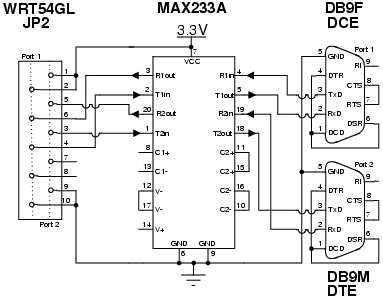File:MAX233A.png
Jump to navigation
Jump to search
MAX233A.png (383 × 300 pixels, file size: 8 KB, MIME type: image/png)
Please note that the diagrams do NOT represent actual placement of the pins on the hardware, which may have been moved to simplify the diagram.
- The component on the left represents the UART head on the main board of the router. The even pins (2,6,4,8,10) represent the data that is sent and received from the first serial port, the odd pins (1,5,3,7,9) the second serial port. Each port has lines for power, ground, transmit, receive, and an unconnected line. These UARTs follow the standard, three-wire "smart modem" connection strategy, and do not make use of hardware flow control lines.
- The component in the middle represents the MAX233A transceiver needed to convert the voltage used to transmit signals in the router (3.3V) to the RS-232 standard signals to send over the serial port.
- The components on the right represent two standard DB9 jacks. The first port is wired to be a DCE with female DB9, implying that this console port connects to a computer. The second serial port is wired as a DTE, with male DB9, implying that this secondary port will connect to other kinds of communications equipment (serial-controlled sensors, etc.,) or perhaps another router's console.
- A computer connecting to the first port would require a standard DB9 serial cable; connecting a computer or other DTE to the second port would require a Null Modem.
File history
Click on a date/time to view the file as it appeared at that time.
| Date/Time | Thumbnail | Dimensions | User | Comment | |
|---|---|---|---|---|---|
| current | 04:34, 5 March 2007 |  | 383 × 300 (8 KB) | Michael (talk | contribs) |
You cannot overwrite this file.
File usage
The following page uses this file:
